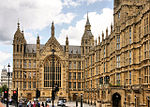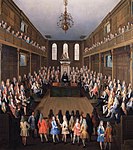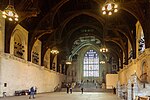Richard Coeur de Lion (statue)

Richard Coeur de Lion is a Grade II listed equestrian statue of the 12th-century English monarch Richard I, also known as Richard the Lionheart, who reigned from 1189 to 1199. It stands on a granite pedestal in Old Palace Yard outside the Palace of Westminster in London, facing south towards the entrance to the House of Lords. It was created by Baron Carlo Marochetti, an Italian sculptor whose works were popular with European royalty and the nobility, though often less well regarded by critics and the artistic establishment. The statue was first produced in clay and displayed at The Great Exhibition in 1851, where it was located outside the west entrance to the Crystal Palace. It was well received at the time and two years later Queen Victoria and Prince Albert headed a list of illustrious subscribers to a fund that aimed to raise money for the casting of the statue in bronze. Although the money was duly raised and the bronze cast of the statue was finally completed in 1856, a lengthy dispute delayed its installation for several years. The original idea had been to erect the statue as a memorial to the Great Exhibition. This prompted opposition, as did proposals to place it outside Charles Barry's newly completed Palace of Westminster. Various other locations to display the statue were initially considered before agreement was reached that it would be placed in Old Palace Yard, Marochetti's preferred location. It was installed in October 1860, though it was not until March 1867 that it was finally completed with the addition of bronze bas-reliefs on either side of the pedestal. The quality of the statue's workmanship caused problems during its first half-century; the horse's tail fell off the day after it was installed at the Great Exhibition, and forty years after its installation it was discovered to be riddled with holes and to have never been properly attached to its pedestal. It narrowly escaped destruction during the Second World War when a German bomb dropped during the Blitz landed a few metres away and peppered it with shrapnel. The pedestal and the horse's tail were damaged and Richard's sword was bent by the blast. In 2009, the Parliamentary authorities undertook a project to conserve and restore the statue.
Excerpt from the Wikipedia article Richard Coeur de Lion (statue) (License: CC BY-SA 3.0, Authors, Images).Richard Coeur de Lion (statue)
Old Palace Yard, City of Westminster Millbank
Geographical coordinates (GPS) Address Nearby Places Show on map
Geographical coordinates (GPS)
| Latitude | Longitude |
|---|---|
| N 51.499157 ° | E -0.125584 ° |
Address
Old Palace Yard
Old Palace Yard
SW1P 3JY City of Westminster, Millbank
England, United Kingdom
Open on Google Maps











